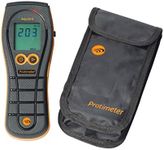Buying Guide for the Best Wood Moisture Meters
Choosing the right wood moisture meter is essential for anyone working with wood, whether you're a professional carpenter, a DIY enthusiast, or someone who needs to ensure the quality of firewood. A wood moisture meter helps you measure the moisture content in wood, which is crucial for preventing issues like warping, cracking, or mold growth. To find the best fit for your needs, you should consider several key specifications and understand how they impact the performance and usability of the meter.Type of MeterThere are two main types of wood moisture meters: pin-type and pinless. Pin-type meters use two metal probes that you insert into the wood to measure moisture content, which can provide very accurate readings but may leave small holes. Pinless meters use electromagnetic sensors to scan the wood's surface, which is non-destructive but may be less accurate on very thick or dense wood. Choose a pin-type meter if accuracy is your top priority and you don't mind minor damage to the wood. Opt for a pinless meter if you need a quick, non-destructive method and are working with finished or delicate wood surfaces.
Measurement RangeThe measurement range indicates the range of moisture content that the meter can detect, usually expressed as a percentage. This is important because different types of wood and different applications require different moisture levels. For example, construction lumber typically needs to be between 15-19% moisture content, while furniture wood should be between 6-8%. Choose a meter with a range that covers the moisture levels relevant to your specific projects. If you work with a variety of wood types, a broader range will be more versatile.
AccuracyAccuracy refers to how close the meter's readings are to the actual moisture content of the wood. This is crucial for ensuring the quality and durability of your wood projects. Accuracy is usually expressed as a percentage, such as ±1%. Higher accuracy is better, especially for critical applications like fine woodworking or construction. If precision is essential for your work, look for a meter with a high accuracy rating. For less critical applications, a slightly lower accuracy may be acceptable.
Depth of MeasurementDepth of measurement indicates how deep into the wood the meter can measure moisture content. This is important because moisture levels can vary at different depths. Pin-type meters typically measure at the depth of the pins, while pinless meters can vary in their depth capabilities. If you need to measure moisture deep within thick pieces of wood, choose a meter with a greater depth of measurement. For surface-level measurements or thinner wood, a shallower depth will suffice.
Display and ReadabilityThe display and readability of the meter are important for ease of use. Look for a meter with a clear, easy-to-read display that shows the moisture content in a straightforward manner. Some meters have backlit displays, which can be helpful in low-light conditions. If you often work in dimly lit areas or need to take quick readings, a meter with a large, backlit display will be more convenient. For occasional use in well-lit environments, a standard display may be adequate.
Additional FeaturesAdditional features can enhance the functionality and convenience of a wood moisture meter. Some meters come with built-in calibration, temperature compensation, or the ability to store and recall readings. These features can be useful for ensuring accurate measurements and tracking moisture levels over time. Consider what additional features might be beneficial for your specific needs. If you require precise and consistent measurements, features like calibration and temperature compensation are valuable. For basic, occasional use, these extras may not be necessary.

















